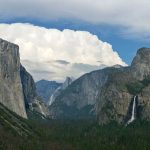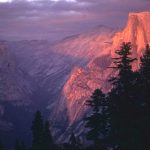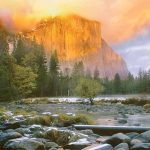Photos of over a hundred Yosemite birds are at:
https://www.audubon.org/climate/national-parks/yosemite-national-park
color drawings and descriptions of common Yosemite birds: http://www.nps.gov/yose/naturescience/birds-common.htm
common birds
https://www.nps.gov/yose/learn/nature/birds-common.htm
How to ID Birds Learn some of the secrets of bird identification using silhouettes, posture, flight pattern, size and habitat, in addition to key field marks.
Where to Bird, Bird Guide, Gear Guide, Attracting Birds, Conservation Links
episode #1 is wildflowers
color drawings of common Yosemite wildflowers: http://www.nps.gov/yose/learn/nature/common-wildflowers.htm
photos of 38 Hetch Hetchy Wildflowers, blooming along the 2.5-mile trail to Wapama Falls in early June 2013.
https://www.nps.gov/media/photo/gallery.htm?id=8139B9CB-155D-4519-3EBDD8573DB305E6
where to see Yosemite wildflowers
https://www.nps.gov/yose/learn/nature/wildflowerviewing.htm
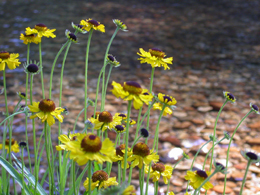
When are the wildflowers best?
.”Wildflowers vary according to location, time of year and the preceding winter and spring weather. The best wildflower displays are:
• Mid-March into April in the foothills outside the park: In the best years there are carpets of California poppies, baby blue eyes, western redbud, etc. Highway 140 through the Merced River Canyon can have a spectacular display.
below: Redbud

• Mid-June into August in Yosemite’s higher elevations: The meadows at Crane Flat and along the Glacier Point and Tioga Roads present beautiful wildflower displays most years.
Yosemite Valley never really gets a “carpeted” display of wildflowers. Perhaps the heavy grazing pressure and soil compaction the Valley meadows received many decades ago has caused this. However, the dogwood tree blossoms in early May are usually a nice display as are the bushy western azalea of late May into mid-June. All summer there are little pockets of flowers scattered about Yosemite Valley.”
“The most diverse mix of wildflowers is actually just outside the park’s Western boundary on the trail above the South Fork of the Merced River that extends from historic Savage’s Trading Post to Hite’s Cove. Over fifty species of flowers may be found between March and May along this picturesque path.”
“ Fall Color Advisory
All spring and summer leaves have been using pigments (chlorophylls, xanthophyll, and carotenoids) to make food from air, water, and sunlight. As temperatures cool and days get shorter, leaves on deciduous trees stop producing chlorophylls and the familiar green color fades away to reveal the other pigments which have been masked all season. Quaking aspen and big-leaf maple display the yellow carotenoids. Continued sunny days and cool nights trap sugars in leaves and some leaves will form the red pigment anthocyanin, coloring trees like dogwoods or the non-native sugar maple across from the Chapel, or vines like the poison-oak along the El Portal Road a brilliant orange, pink, or even purple. The best autumn colors occur under clear, dry, and cool but not freezing weather. The degree of color may vary from tree to tree and even leaf to leaf. Leaves directly exposed to the sun may turn red, while shaded leaves may be yellow. Leaves on some trees like white alders or California buckeyes (which are “summer deciduous” as a drought adaptation) just wither and turn brown. Leaves on marsescent trees, like some California black oaks, will linger all winter and only fall next spring when new leaves emerge. Live oaks, tanoaks, bay laurel and the conifers will keep their newest leaves throughout the winter to get a head start on food production next spring. (Adapted from Why Leaves Change Color, USDA FS-12 and Physiology of Woody Plants, Kramer and Kozlowski, by Brian Mattos) (K. Shive)”
http://pubs.usgs.gov/bul/1595/report.pdf
Download full color geologic maps of Yosemite Valley at:
http://geomaps.geosci.unc.edu/parks/parks.htm
Using a drone is illegal in Yosemite National park, including for photography. See an index to over a dozen park webpages with park laws, rules, regulations, policies and prohibitions about pets, bikes, permits, campground regulations, food storage, smoking, speed limits . . . and much more.
In the May 2, 2003 notes he says “Nice late-afternoon sunlight strikes Bridalveil Fall about an hour-and-a-half before sunset (about 6:30 p.m.) in May and June. …The best light on Upper Yosemite Fall occurs around 10 a.m. and about 3 to 4 p.m.”
In the June 20 notes he says that the best light for photos of Vernal Fall is from 5 to 6 p.m. and the best time for Nevada Fall is 6:30 to 7 p.m.
Other notes tell us that the dogwood peak bloom should be early to mid May and the redbud in mid March. Best fall color varies from year to year from mid October to mid November.
November, December, and January are the best months to photograph Half Dome and El Capitan. From late afternoon until sunset, low-angle sunlight highlights the texture on the face of Half Dome. Late in the day, El Capitan is also flushed with warm light.

Where were they when they got that great picture in Yosemite?
Where can I get a photo that looks like the one on a Yosemite postcard I just bought?
Places to take photos of Half Dome, Bridalveil Fall, El Capitan, Yosemite Falls and Staircase Falls.
The author recommends taking upper Yosemite Fall shots from the parking lot just north of Sentinal Bridge, shuttle bus stop 11 Yosemite Valley free shuttle bus
https://www.lightningmaps.org/blitzortung/america/index.php?lang=en
and see:
https://www.accuweather.com/en/us/national/severe-weather-maps
You can read these books about Yosemite by John Muir for free:
The Mountains of California http://www.gutenberg.org/ebooks/10012
Can I recommend these chapters?
VII THE GLACIER MEADOWS
XII SIERRA THUNDER-STORMS
XIII THE WATER-OUZEL
The Yosemite http://www.gutenberg.org/ebooks/7091
some favorite chapters include:
Winter Storms and Spring Floods
Snow-storms
Snow Banners
Yosemite rock fallsin Yosemite 2008 to the most recent report and safety tips for hikers
Bears Bears has how bears break into cars in Yosemite National Park and how to prevent it happening to you (with lots of photos of actual bears climbing in to cars), what to do if you see a bear, how to store food away from bears and more.
How much water will there be in the Yosemite waterfalls?
How to find the location of John Muir’s cabin (hang nest) in Yosemite Valley
The same shot of Yosemite Falls in three pictures: a flooded Sentinel Meadow taken May 16, June, 2005 and a snow covered February 4, 2008. Yosemite Falls View in Three Seasons
Thunderstorm and lightning safety includes the answer to the question: Why can’t you swim during a lightning storm? A strike on a lake doesn’t kill all the fish in the lake. AND What is it like when lightning strikes?
World’s greatest swimming hole
Yosemite Valley free shuttle bushas the route, stops and how to find the store, shower house, trailheads and hints for saving time using the free bus by better understanding the route, as well as basic info about fee buses in Yosemite
Yosemite Valley Rafting Advice
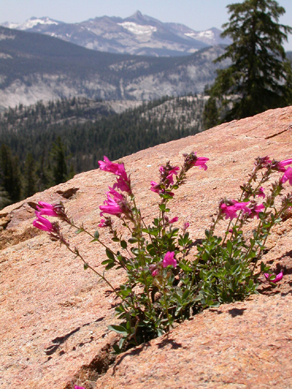
http://www.nps.gov/hfc/index.htm
click on NPS photos
——————————————————————-
The author of this webpage, (written as for my students), does not give any warranty, expressed or implied, nor assume any legal liability or responsibility for the accuracy, completeness, or usefulness of any information, product, or process included in this website or at websites linked to or from it. Users of information from this website assume all liability arising from such use.
